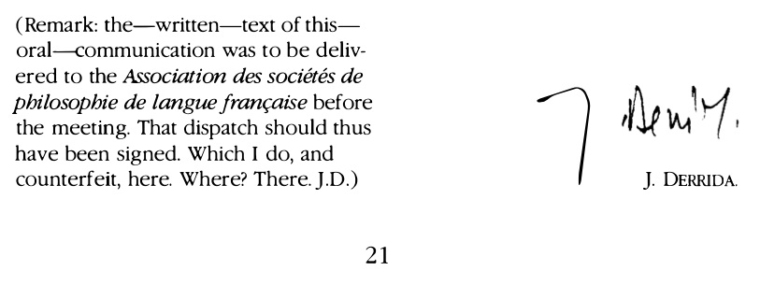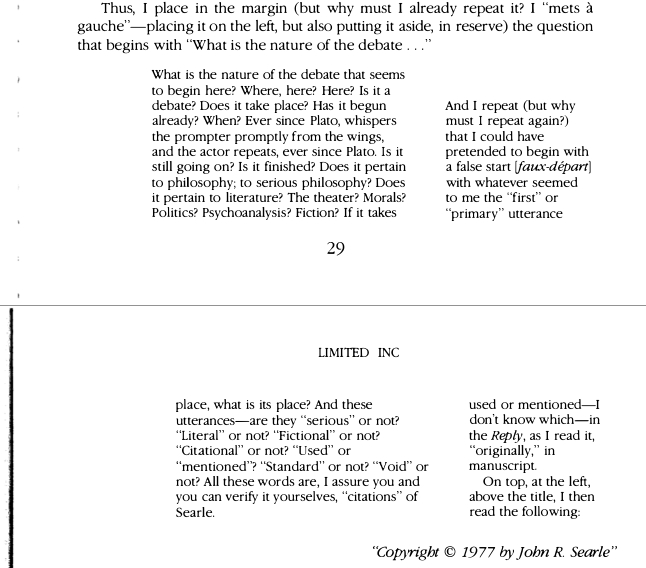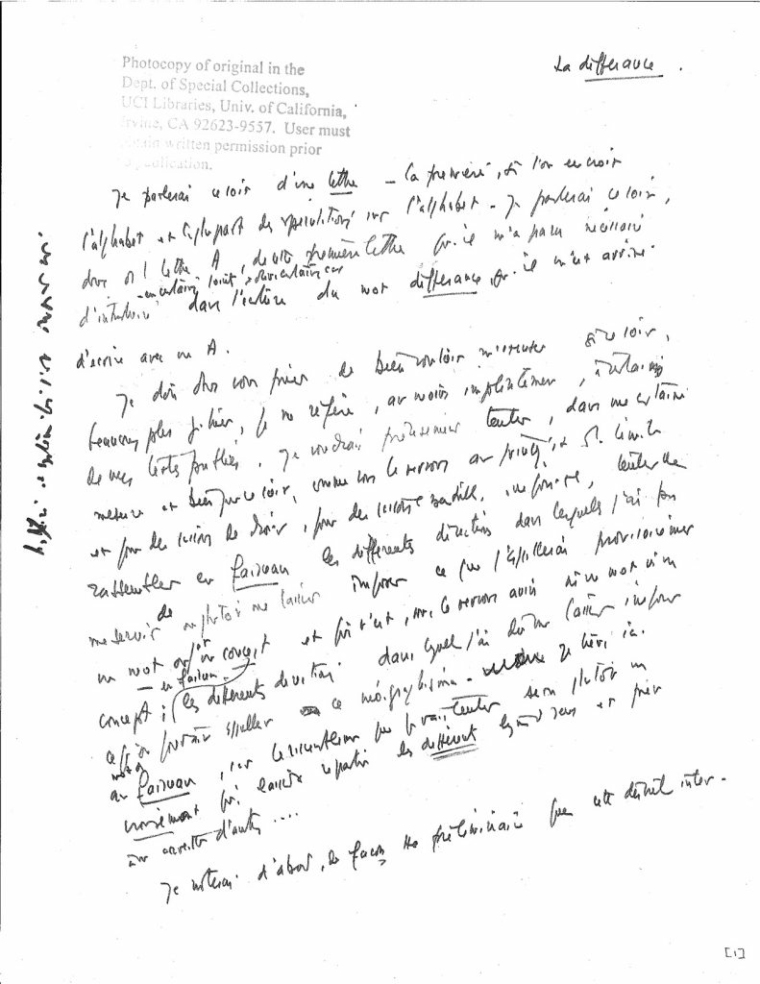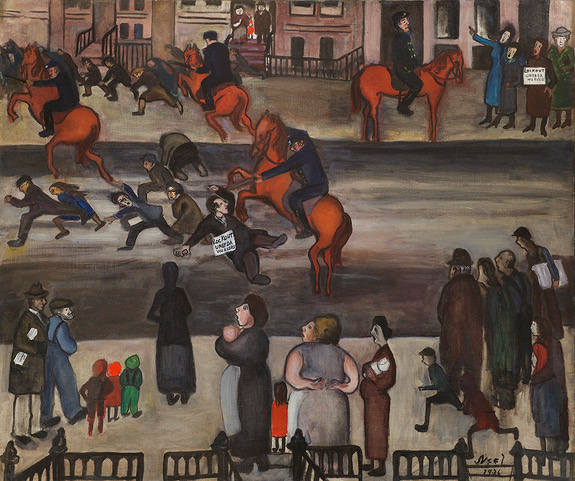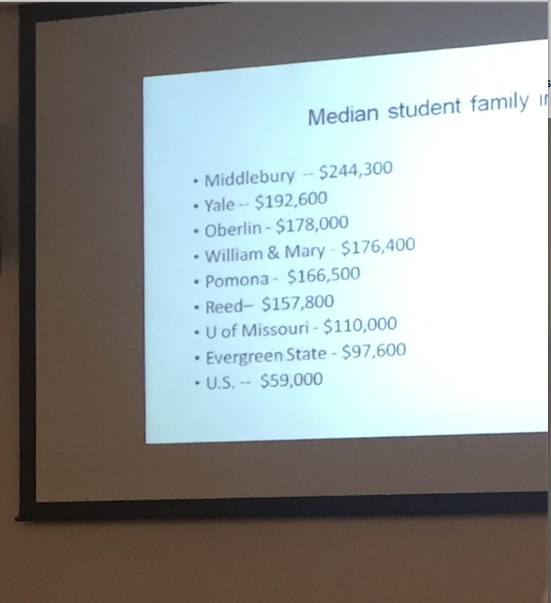Another way to get at this is just to say that the identification of what the text means with what the author intends is already in place without our having any recourse to a theory of intention or to a positive account of intention as a mental state. While the work that it does in place—determining the act—makes clear the mistake in imagining that the text we write could be either controlled by or liberated from what we meant.
The reason Derrida does not think intentions are governing is because he thinks the condition of having a (linguistic or semiotic) one entails a form of repeatability that the intention cannot fully master. Yet there also cannot be any text-y things, written or spoken or semiotic, without intention playing some role. Moreover, as an interpreter, Derrida wants both: he wants to interpret faithfully the intention, as Henry pointed out, and read what is not available as an intention but inscribed in a text (which reading also produces). Not one or the other, but both.
The problem, as we’ve already begun to see, is that once you’re committed to the idea that meaning is something you try to control and/or that it’s something you impose, you’re committed also to an account of the text in which the intention must be (what Derrida rightly denies it can be) outside of it. Indeed, this is exactly what the reduction of the text to the mark requires since the act of writing is here conceived as the writer’s effort to impose a meaning on the mark she has made and since the act of reading involves the impositions of other meanings, which need not be the same as the writer’s. The reason the mark is abandoned is because that imposition necessarily fails, leaving a remainder that remains necessarily “open.”
This is what Kenner calls the Gulliver game, embodied in its purest form in the Turing game, which identifies what it is to be human with the ability to produce the Goodmanian letters and spaces that would look just like the letters and spaces a human would produce, thereby making the computer indistinguishable from the human. The computer (and here he anticipates John Searle’s Chinese Room argument, which makes sense since Goodman’s idea of a text is a syntax independent of any semantics) is the most advanced player in the you’re not allowed to understand what you’re talking about game.
If we take the question about art that is supportive of the PMC as a question about art that is supportive of capitalism, we can see that it’s only incidentally a question about art’s compatibility with the self-understanding of one class rather than another. It’s fundamentally a question about what there can be in art that isn’t reducible to the self-understanding of any class.
Undoubtedly, economic inequality is an enormous problem in a democratic society where citizens claim to value egalitarian norms. But this puzzling juxtaposition misses some fundamental points. The first is that racial identity is not merely a “celebration of difference,” nor is it a distraction from efforts to achieve economic inequality. Suggesting that attending to identity politics is what keeps us from fighting growing inequality is just barking up the wrong tree.
Every time racial disparity is invoked as the lens through which to see American inequality, the overwhelming role played by the increased inequality in the American class system is made invisible. And this is, of course, true on the right as well as the left—think of all the conservative commentators defending the police by invoking the spectre of black-on-black murder. And then think of the widespread agreement among criminologists that the Gini coefficient “predicts murder rates better than any other variable.” Conservatives who try to blame black crime on race and liberals who try to blame it on racism are both missing the point. If you want to distinguish between the left and the right, the relevant question is not what they think about race; it’s what they think when race is taken out of the equation.
This would be, from the standpoint of literary theory, why Anscombe is helpful. What John Schwenkler calls her “fundamental disagreement” with the idea that “we find intentional activity whenever a person…causes something to happen” is a fundamental disagreement with the idea that we can think of a person’s intention as the cause of her acts, which is the idea that anti-intentionalists like Wimsatt and Beardsley and intentionalists like Nehamas and Landy have completely in common. So I disagree with Landy both on the utility of the postulated author and the irrelevance of Anscombe
By contrast, what the idea of the rule provides is a relation to the self—to sleeping, washing, eating, excreting and reflecting—that embodies an understanding of the social constituted neither by an assemblage of solitaries nor by the model of the epistolary relations between the writer and the “others” whose “help” he needs to cultivate himself properly. It would be too much to say that in the seven “Deserts” we see the struggle between capital and labor. But it would be exactly right to say that we see emblems not of self-care but of both conflict and of ideology.
This is why some of us have been arguing that identity politics is not an alternative to class politics but a form of it: it’s the politics of an upper class that has no problem with seeing people left behind as long as they haven’t been left behind because of their race or sex. And (this is at least one of the things that Marx meant by ideology) it’s promulgated not only by people who understand themselves as advocates of capital but by many who don’t.


